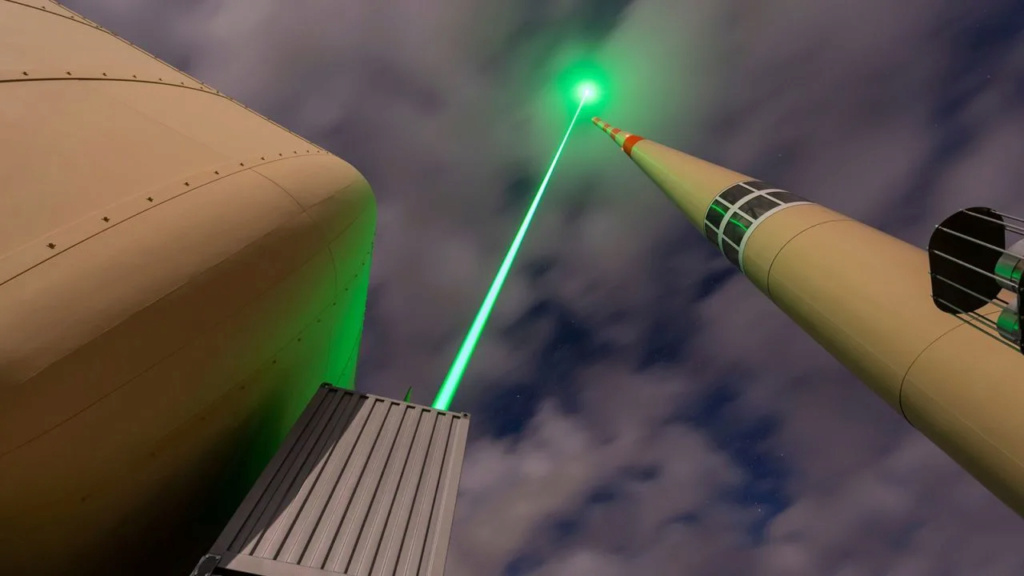A new scientific breakthrough..Scientists succeed in scattering atmospheric lightning with a huge laser

Dubai, United Arab Emirates (CNN) – Scientists have succeeded in erecting a virtual lightning rod, using a large and powerful laser, from a mountain in Switzerland, which was able to divert the path of aerial lightning strikes.
Lightning deflection technology has not changed much since Ben Franklin invented the lightning rod in 1752. The Franklin rod is the most common device for lightning protection, and it is an electrically conductive metal electrode, placed on the roofs of buildings and others, that intercepts lightning strikes and leads them safely toward the ground.
But the area of protection provided by Franklin lightning rods is proportional to their height, with a 10-meter (32.8-foot) lightning rod protecting a 10-meter radius.
Since the height of lightning rods is not infinite, large areas such as airports, launch pads, power plants, wind farms, and nuclear power plants are a challenge.
Lightning kills about 24,000 people annually, and can cause power outages, wildfires and damage to infrastructure, according to a detailed study published in the journal Nature Photonics, Monday.
The scientists decided to test whether a laser beam directed at the sky could act as a large, moving virtual lightning rod. Previous research supported the idea that laser pulses could affect the path of lightning strikes, but that was only done inside a laboratory.
A laser the size of a large car has been installed near a communications tower atop Mount Santis in northeastern Switzerland, where lightning strikes about 100 times a year.
The researchers activated the laser in the summer of 2021 for more than six hours during thunderstorm events between June and September. And the Lightning Rod Laser, as the European consortium that made it calls it, deflected four lightning strikes.

High-speed cameras recorded those strikes, and further observations were taken using the high-frequency electromagnetic waves generated by the lightning as well as the X-ray beams associated with the strikes.
"When high-energy laser pulses are emitted into the atmosphere, filaments of extremely intense light form within the beam," study co-author Jean-Pierre Wolfe, professor of applied physics at the University of Geneva, said in a statement.
These filaments ionize nitrogen and oxygen molecules in the air, which then release free-moving electrons. This ionised air, called plasma, becomes electrically conductive.
Active particle laser channels helped direct lightning strikes along a laser beam that could fire about 1,000 pulses per second.
The Laser Lightning Rod weighs more than 3 tons, is 1.5 meters (4.9 feet) wide and 8 meters (26.2 feet) long.
The device was tested at an altitude of 2,502 meters (8,208 feet) atop Mount Santis, and was designed by TRUMPF Laser Science based in Munich, Germany to work even under difficult weather conditions, such as the fog that often drifts around the top of the mountain.

Each time storm activity was expected around the mountain during the experiment, the area was closed to air traffic.
The study's lead author Aurelien Howard, research scientist at Laboratoire d'Optique Appliquée, said in a statement: "The aim was to see if there was a difference with or without the laser. We compared data collected when the laser fuse was produced on top of the tower and when lightning struck the tower." Normally". The research team worked for about a year to analyze the data collected during the experiment.
Wolf added: “Starting with the first laser bolt, we found that the charge could follow the beam for approximately 60 meters before reaching the tower, which means that the laser increased the radius of the protection surface from 120 meters (390 feet) to 180 meters (590 feet).” .
Next, the research team seeks to increase the laser's power by expanding its reach and the area it protects, in hopes that it could one day be used as a traditional replacement for a lightning rod in large areas.
Source: websites

